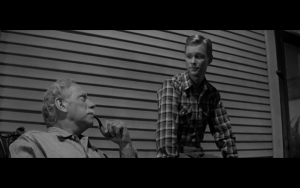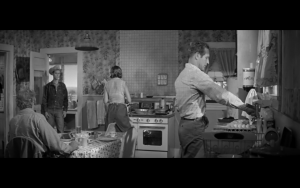Exercise 8 Reflection
This week we spent a class working together as a crew to set up and light a very simple conversation scene between Aria and Ryan. I really enjoy these exercises as they are what I had in mind when I signed up for this studio. I also realised that when we have these practical days I actually prefer to not be one of the people involved in the crew and to instead be an observer the whole time. I feel that if I were assigned one of the crew roles it would take up too much of my mind to be able to properly concentrate on what is happening within the scene. If I am simply watching then I can observe every aspect of the crew and have a clearer understanding of why everyone is doing what they are doing and absorb the exercise that way.
I always love watching these practical exercises as there are always things pointed out or decisions made that I would have never thought about, mostly in the vain of me not being meticulous enough in analysing the light in the scene. For example in this exercise I specifically remember a moment where Robin and the Crew decided that a spot of light on Aria’s neck was too bright and hot and that it needed to be cut down because it overpowered and dominated the frame. From my memory they solved this by either cutting or diffusing where that specific spot of light was coming from and when I saw the difference I was very impressed by how such a subtle change really made the picture look better. I always have several of these moments any time we have practical exercises such as this and I think it really helps me to sharpen my sensitivity to light and to have a clearer vision and more conviction in my mind in regards to cinematography.
Presentation Summary
Our group (mainly Ryan) presented our idea to the class which I thought went reasonably well considering how unsure we were about what we finally wanted to do. We know that we want to find a good location and return to it every week to refine whatever it is we have in mind that we want to film. We all at the start wanted to have a very individualistic mindset to this project, each hoping to come out of this with something to show and claim primary ownership of, but thinking more about it we decided that this would be unnecessarily overwhelming and that it would be better to have at least some overlap between our ideas. We eventually settled on a sort of compromise where we would all visit the same location and film things that were very similar, but that each of us had a different thing that we wanted to investigate, and that that would be enough of an individualistic satisfaction to be gained out of this project.
For me, personally, I want to investigate and experiment with deep focus photography. Lately, having watched a lot of films shot by James Wong Howe and Gregg Toland I have found myself very drawn to deep focus, and I think its because I have always been naturally inclined towards aspects of filmmaking such as blocking and frame composition, and I think that deep focus allows these two aspects of filmmaking to really shine, while also allowing for achievements in cinematography to be attained.
I am thinking of writing a short 1-2 minute scene which will take advantage of the different planes (foreground, midground, background) that will be available because of deep focus and to have the characters I write and the conversation to lead them to move within these plains. Hopefully I will be able to write something good enough where I can move them around the dimensions of the frame with motivation that stems from the narrative desires of the script.
The iterative aspect of the project can be focused on the difference between achieve deep focus in black and white and in colour, and how these two approaches produce different results. Another potential iterative aspect that I am thinking of is first shooting with the EX-3 that we use in class, and then shooting with the Blackmagic Pocket Cinema Camera that I own, and seeing how I will have to adjust the lighting according to the cameras’ specifications.
Thinking about the obstacles that could come up from this project I found a few main ones. One is that I am probably going to need a large volume of light to pull off deep focus, and I will have to remember this when deciding how many external lamps I will take with me to the location and the logistics of it.
Another obstacle could be my desire to write my own scene and to block it accordingly. This is a potential obstacle as I can potentially see myself become too wrapped up with the idea of writing and staging actors that I draw too much of my focus and energy away from actually trying to light and achieve deep focus, which is the main priority of this project.
Lastly, I will be very dependent on the location. Watching the films that have contained deep focus by Toland and Howe I have noticed that pretty much every room that they used has been very large. I may have some trouble finding a location that is adequately large enough so that the deep focus that I pull off feels effective, as deep focus in a large area often feels much more impressive than in a smaller area.
Having found a specific area of film light that I want to investigate, I have become excited to start this project and to see what results are produced. It is also a challenge to me as I am experimenting with something that I have virtually zero experience with.
Presentation Reflection Response
Looking at everyone’s presentations this week I was really impressed by them, seeing how well thought out and articulated everyone else’s vision was made me realise how unfocused our own group’s idea is. I was particularly interested in the group that wanted to shoot outside a place that had red neon lights and to shoot from inside a car. I really liked how they had already storyboarded some shots as well as gone through a lot of potential shortcomings and obstacles comprehensively. In general I think that their idea has the potential to turn out really interesting, especially if they implement some of the things mentioned such as rain/water or superimpose the neon lights.
Something I really liked about the pitches was the feedback from both Paul and Juliet as it was always very practical advice that could be realistically implemented. Juliet’s advice especially I thought was really great as she came from a background in production design, and therefore got us to think a lot about what we put in front of the camera, something that maybe you can tend to forget when getting too wrapped up in lighting and camera stuff. I particularly liked the advice in regards to the Psycho recreation in which she advised them to be mindful about what walls they use and how this will absorb and reflect the light differently as well as telling another group to be mindful about the difference between using a 25mm MFT lens and a 50mm lens on a full frame sensor.
Moving forward after hearing everyone’s pitches I think that our group will try to hone in and refine whatever it is exactly we want to do with this project and to have a more define and articulated vision.















